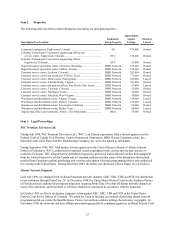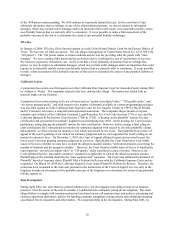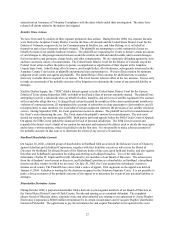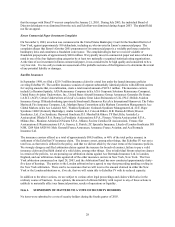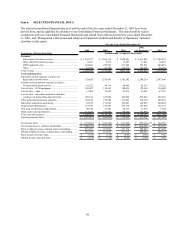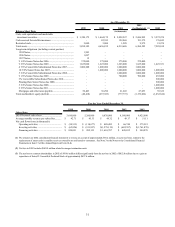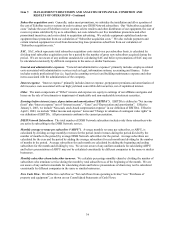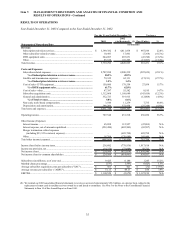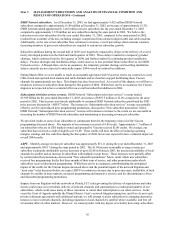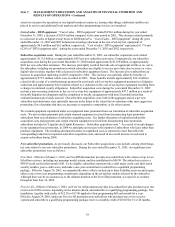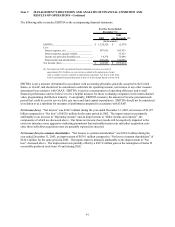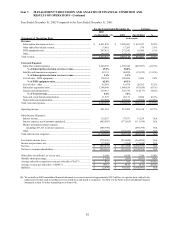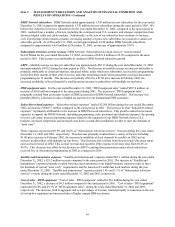Dish Network 2003 Annual Report Download - page 38
Download and view the complete annual report
Please find page 38 of the 2003 Dish Network annual report below. You can navigate through the pages in the report by either clicking on the pages listed below, or by using the keyword search tool below to find specific information within the annual report.Item 7. MANAGEMENT’S DISCUSSION AND ANALYSIS OF FINANCIAL CONDITION AND
RESULTS OF OPERATIONS - Continued
33
promotion, in 2004 we anticipate an increase in the number of subscribers who lease rather than purchase
equipment. The resulting anticipated increase in capitalized costs is expected to more than offset the corresponding
reduction in expensed subscriber acquisition costs, and result in an overall increase in cash used to acquire
subscribers during 2004. Our subscriber acquisition costs, both in the aggregate and on a per new subscriber basis,
may materially increase in the future to the extent that we introduce more aggressive promotions in response to new
promotions offered by our competitors.
Maintain or improve operating margins. We will continue to work to generate cost savings by improving our
operating efficiency and attempting to control rising programming costs. Our operating margins may be adversely
impacted by rising programming costs. Payments we make to programmers for programming content represent one
of the largest components of our operating costs. We expect programming providers to continue to demand higher
rates for their programming. We will continue to negotiate aggressively with programming providers in an effort to
control rising programming costs. However, there can be no assurance we will be successful in controlling these
costs. In addition, there can be no assurance that we will be able to increase the price of our programming to offset
these programming rate increases without affecting the competitiveness of our programming packages.
Financial Statement Restatement
During February 2004, we consulted with the Securities and Exchange Commission (“SEC”) regarding our accrual
for the replacement of smart cards. Those cards, which provide security that only paying customers can receive
programming delivered by us, become obsolete as a result of piracy. During the consultation process, the SEC
informed us that it believes we over reserved approximately $30.2 million for the replacement of certain smart cards.
During prior years, ending in 2002, we accrued the estimated cost to replace those cards, which are included in
satellite receivers that we sell and lease to consumers. The SEC did not object to the accruals to replace the smart
cards in satellite receivers sold to and owned by consumers. However, the SEC believes that we over reserved
approximately $30.2 million, on a pre-tax basis, for the replacement of smart cards in satellite receivers owned by us
and leased to consumers.
On March 12, 2004, the SEC informed us it would not object if we restated our financial statements for 2002 to
record a reversal of the accruals for the replacement of these smart cards of approximately $4.2 million,
$17.2 million and $8.8 million which were originally accrued in 2000, 2001 and from January 2002 through June
2002, respectively. As a result, we have restated our financial statements for 2002 to reduce previously reported
Subscriber related expenses, operating losses and pre-tax losses by approximately $30.2 million.
Explanation of Key Metrics and Other Items
Subscription television services revenue. “Subscription television services revenue” consists principally of revenue
from basic, movie, local, international and pay-per-view subscription television services, as well as rental and
additional outlet fees from subscribers with multiple set-top boxes.
DTH equipment sales. “DTH equipment sales” consist of sales of digital set-top boxes by our ETC subsidiary to Bell
ExpressVu, a DBS service provider in Canada. “DTH equipment sales” also include sales of DBS accessories to DISH
Network subscribers and to retailers and other distributors of our equipment.
Subscriber-related expenses. “Subscriber-related expenses” include costs incurred in the operation of our DISH
Network customer service centers, programming expenses, copyright royalties, residual commissions, and billing,
lockbox and other variable subscriber expenses. “Subscriber-related expenses” also include costs related to
subscriber retention.
Satellite and transmission expenses. “Satellite and transmission expenses” include costs associated with the
operation of our digital broadcast centers, the transmission of local channels, contracted satellite telemetry, tracking and
control services and transponder leases.
Cost of sales – DTH equipment. “Cost of sales – DTH equipment” principally includes costs associated with digital
set-top boxes and related components sold to Bell ExpressVu and sales of DBS accessories to DISH Network
subscribers and to retailers and other distributors of our equipment.


